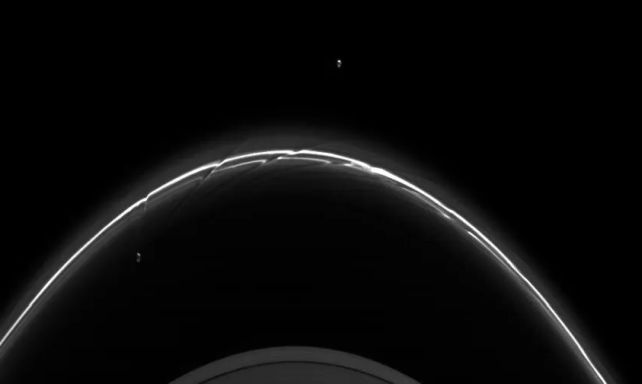The secret lives of minor planets may be even more complex and fascinating than we thought.
Scientists have discovered that a pair of gossamer rings circling an asteroid-like chunk of rock in the cold reaches of space out past Jupiter are likely being shepherded by a tiny, unseen moonlet.
The rock is named Chariklo, a type of minor planet known as a centaur – an asteroid-like body that orbits the Sun in the space between Jupiter and Neptune (rather than between Jupiter and Mars, where the asteroid belt spans).
Chariklo, just 250 kilometers (155 miles) in diameter, is the only known centaur or asteroid with rings – and it sports not one, but two.
How asteroids maintain rings is not known. But, led by astronomer Amanda Sickafoose of the Planetary Science Institute, a pair of scientists has conducted simulations and found that moonlets are a plausible explanation.
"Rings around minor planets have only been recently discovered, and only a small number of such systems are currently known," Sickafoose says.
"There has been significant research into the dazzling rings around the giant planets; however, the mechanisms of ring formation and evolution around small objects are not well understood. We've shown that one of the possibilities for thin rings to exist around small bodies is that they are being sculpted by a small satellite."
Rings in the Solar System aren't uncommon, actually. Half the planets (Jupiter, Saturn, Uranus, and Neptune) have known rings, and some dwarf planets do too. They usually consist of small dust and ice grains that circle a body's equator, bound in gravitational orbit, like a deconstructed moon.
We are finding an increasing number of asteroids that have moons, so minor planets with small rings aren't the weirdest things imaginable. But two very distinctly defined rings, as Chariklo has, are interesting.
Sickafoose and her colleague, computer scientist Mark Lewis of Trinity University, wanted to find out what keeps the rings so tidy.
They conducted a series of N-body simulations using modified code originally designed to understand Saturn's rings, and altered different parameters to try to replicate the Chariklo system.

The researchers found that a single tiny moon as small as 1 kilometer (0.62 miles) in diameter can maintain gossamer rings similar to those seen circling Chariklo, shaping them and keeping a gap between them in a similar fashion to Saturn's shepherd moons. In fact, such a moon might even be necessary.
"Planetary rings will naturally spread or disperse over time. Chariklo exhibits two thin rings, a few kilometers in width. In order for the rings to stay this thin, there needs to be a mechanism to confine the material and prevent it from dispersing," Sickafoose says.
"We actually show this in the paper by simulating a Chariklo-like ring system that does not have a satellite, and we find that the width of the rings increases linearly with time. This is unlike the situation when there is a satellite in resonance with the ring material, which acts to confine the rings into the kilometer-sized widths that are observed."
Interestingly, the two rings are very close to a distance from Chariklo known as the Roche limit. That's the critical distance at which the rings should start clumping together under gravity and forming moons themselves. However, a small moon can keep a ring perturbed enough that it remains a ring. So that's another factor that could be in favor of a moonlet.
Unfortunately, given how small and far away Chariklo is, and how much smaller any moon must be, we won't be able to get any pictures of such a moon without sending out a mission to get a bit closer. There may also be some indirect way of detecting whether or not there's a moon orbiting Chariklo and keeping its rings in check.
It's also not clear what the rings are made of. Ice probably accounts for quite a substantial proportion, but we don't know how big the particles are or how they interact. Finding out these details will help figure out what, exactly, is going on with this fascinating object.
The research has been published in The Planetary Science Journal.
https://news.google.com/rss/articles/CBMiYGh0dHBzOi8vd3d3LnNjaWVuY2VhbGVydC5jb20vbXlzdGVyaW91cy1yaW5ncy1hcm91bmQtc3BhY2Utcm9jay1taWdodC1iZS1jYXJ2ZWQtYnktYS1zZWNyZXQtbW9vbtIBAA?oc=5
2024-02-11 09:03:12Z
CBMiYGh0dHBzOi8vd3d3LnNjaWVuY2VhbGVydC5jb20vbXlzdGVyaW91cy1yaW5ncy1hcm91bmQtc3BhY2Utcm9jay1taWdodC1iZS1jYXJ2ZWQtYnktYS1zZWNyZXQtbW9vbtIBAA
Bagikan Berita Ini














0 Response to "Mysterious Rings Around Space Rock Might Be Carved by a Secret Moon - ScienceAlert"
Post a Comment